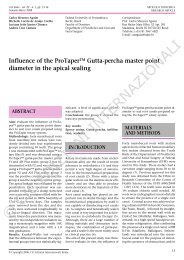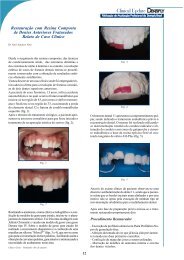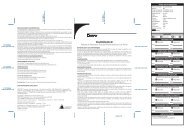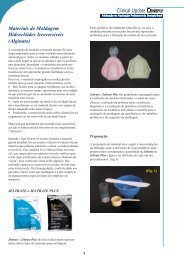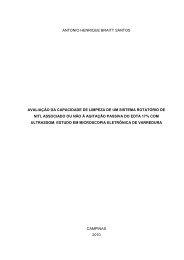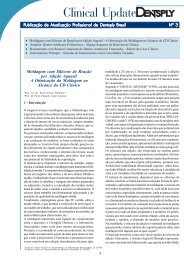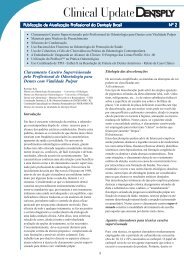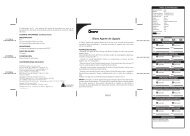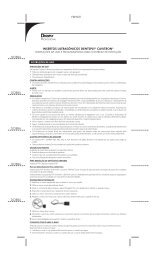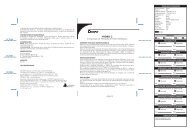You also want an ePaper? Increase the reach of your titles
YUMPU automatically turns print PDFs into web optimized ePapers that Google loves.
Frankenberger et al<br />
Table 1 Overview of materials under investigation<br />
Adhesive +<br />
resin composite<br />
XP BOND/SCA +<br />
Calibra<br />
Syntac<br />
(with Calibra)<br />
OptiBond FL<br />
(with Calibra)<br />
Components<br />
Etchant: 36% phosphoric acid<br />
Primer/Bond: TCB resin, PENTA, UDMA, TEG-DMA, BHT, CQ, functionalized<br />
nanofiller; mixed with SCA (self-curing activator)<br />
Luting composite:<br />
Base: bis-GMA, EBPADM, silica, UDMA, TEG-MA, butylhydoxitoluol, barium<br />
glass, silica<br />
Catalyst: bis-GMA, EBPADM, silica, UDMA, TEG-MA, butylhydoxitoluol, benzoyl<br />
peroxide, barium glass, silica<br />
Etchant: 35% phosphoric acid<br />
Primer: maleic acid 4%, TEG-DMA, water, acetone<br />
Adhesive (2nd primer): water, PEG-DMA, glutaraldehyde<br />
Heliobond: bis-GMA, UDMA, TEG-DMA<br />
Luting composite: see above<br />
Etchant: 37.5% phosphoric acid<br />
Primer: HEMA, GPDM, MMEP, ethanol, water, initiators<br />
Adhesive: bis-GMA, HEMA, GPDM, barium-aluminum borosilicate glass,<br />
disodium hexafluorosilicate, fumed silica (total=48% filler)<br />
Luting composite: see above<br />
Manufacturer<br />
<strong>Dentsply</strong> DeTrey; Konstanz,<br />
Germany<br />
Ivoclar Vivadent; Schaan,<br />
Liechtenstein<br />
Kerr; Orange, CA, USA<br />
for luting of Class I resin composite inlays after different<br />
contaminations, temporary cement removal, and curing<br />
modes. The null hypothesis was twofold, that (1) different<br />
adhesives with different curing modes, and (2) different<br />
temporary cements and cleaning methods would have no<br />
influence on dentin bond strength beneath adhesively luted<br />
inlays.<br />
MATERIALS AND METHODS<br />
Ninety-six intact, noncarious, unrestored human third molars<br />
were stored in an aqueous solution of 0.5% chlora<br />
mine T at 4°C for up to 30 days. The teeth were debrided of<br />
residual plaque and calculus, and examined to ensure that<br />
they were free of defects under a light microscope at 20X<br />
magnification. Standardized Class I cavity preparations (4<br />
mm in width and length, 3 mm in depth) were performed.<br />
Cavities were cut using coarse diamond burs under profuse<br />
water cooling (80 μm, Two-Striper Prep-Set, Premier; St Paul,<br />
MN, USA), and finished with a 25-μm finishing diamond. Inner<br />
angles of the cavities were rounded and the margins<br />
were not bevelled. To guarantee a rectangular relation between<br />
the bonded interface and the direction of the later-cut<br />
μTBS beam, the cusps were flattened by 2 mm and then the<br />
cavity floor was prepared parallel to the flattened cusps.<br />
Direct resin composite inlays (Clearfil AP-X, Kuraray;<br />
Tokyo, Japan) were manufactured under isolation of the cavities<br />
with glycerine gel. The inlays received a cubic shape<br />
with the surface being parallel to the bottom of the cavity to<br />
facilitate positioning of the light-curing tip. The bottom sides<br />
of the inlays were sandblasted with aluminum oxide (Rondoflex<br />
27 μm, KaVo; Biberach, Germany), washed with 70%<br />
ethanol, and dried. The prepared teeth received provisional<br />
restorations (Fermit N, Ivoclar Vivadent; Schaan, Liechtenstein),<br />
and were stored in distilled water at 37°C for one<br />
week. The provisional restorations were either inserted with<br />
or without two different temporary cements (Temp Bond /<br />
Temp Bond NE, Kerr; Orange, CA, USA). Two more groups<br />
with hybridizing dentin prior to temporizing were also made,<br />
either with one coat of adhesive (immediate dentin sealing 17<br />
[IDS]) or with one 0.5-mm layer of flowable resin composite<br />
(X-Flow, <strong>Dentsply</strong> DeTrey; Konstanz, Germany) (resin coating<br />
technique 13 [RC]). Here, temporary cements were omitted<br />
because they play no role in bonding to dentin.<br />
After removing Fermit, cement remnants were removed<br />
with a scaler or using different air-polishing powders (Prophypearls<br />
Powder, KaVo; ClinPro Prophy Powder, 3M ESPE;<br />
Seefeld, Germany), both operating in a Prophyflex air-polishing<br />
device (KaVo) at the level of the occlusal cavity margin<br />
for 10 s. 2 After rinsing with tap water and drying, the cavities<br />
were treated with different adhesives and one luting<br />
composite (Table 1). Internal surfaces of the resin composite<br />
inlays were silanized with Monobond S (Ivoclar Vivadent),<br />
dried, and covered with the respective adhesive, which was<br />
not light cured. Adhesives and luting resin composite were<br />
polymerized with a Translux CL light-curing unit (Heraeus<br />
Kulzer; Dormagen, Germany). The intensity of the light was<br />
checked periodically with a radiometer (Demetron Research;<br />
Danbury, CT, USA) to ensure that 600 mW/cm 2 was always<br />
exceeded during the experiments. Adhesives were light<br />
cured for 40 s in the case where the protocol advised it. Oth-<br />
270 The Journal of Adhesive Dentistry



